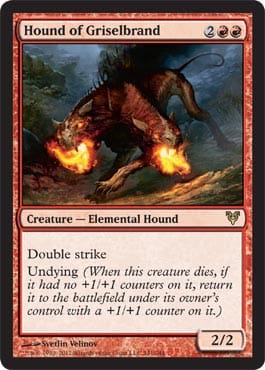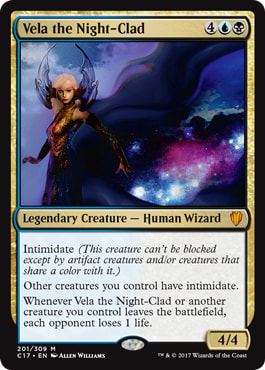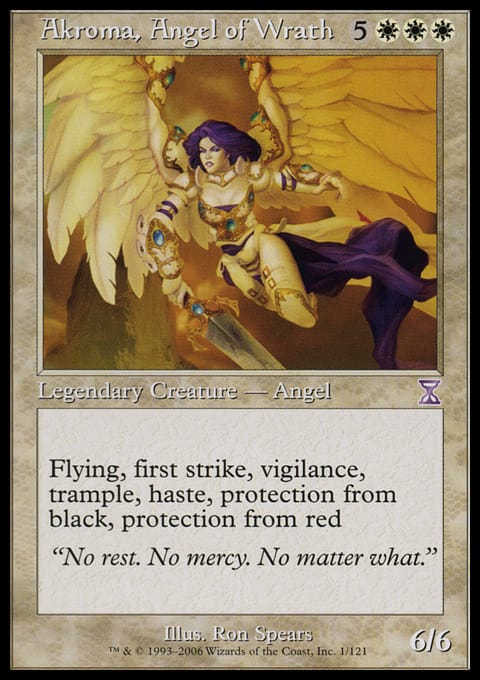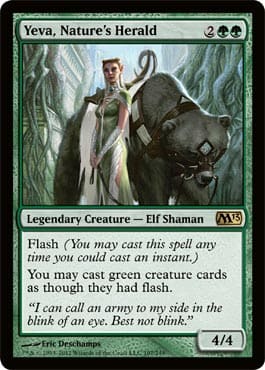Like most games, Magic has grown more complex over time. While some confusing rules were removed, such as the damage prevention phase and interrupts, the addition of everything from Equipment to planeswalkers has really pushed the complexity of the game. Sure, every once in a while, they scrub out the rules in a few corner cases to simplify again a bit (no more mana burn). Nevertheless, the game has grown more complex over time, and we all have to admit that.
I’m not saying this is a bad thing in and of itself. Advanced Dungeons & Dragons was way better than simple ol’ Dungeons & Dragons as it initially debuted. Similarly, American football is better now than it was a hundred years ago with more rules, more emphasis on safety, and safety equipment. Sure, it’s more complex, but that’s in a good way. Chess is a better game than checkers because it’s more complex. Shoot, my own collectable card game I made around Doctor Who is pretty complex when compared to the Pokémon CCG or something. Complexity should be understood and allowed when it makes your game better.
We now have a ton of evergreen keywords running around. These are abilities that creatures can have in any set, including the core sets. I counted sixteen evergreen keywords when I looked through the rulebook. A ton of articles have been written about which of these keywords are good in Draft and tournament duels. Because of that, I’d like to discuss those abilities in a multiplayer universe. When you are playing Commander with your friends or you’re playing multiplayer at the card store, this is how I believe the abilities shake out. In multiplayer, many abilities are at different levels of power.
The Back 5
I like to have a few Honorable Mentions in my Top 10 articles. With just sixteen possible candidates, I thought it would be good to explain the five worst abilities from this list and then give just one Honorable Mention. Here are the three worst:
16. Defender – Since it’s the only disadvantage keyword, it’s clearly always going to be the back of any list. But it’s not that bad. Take off defender from Fog Bank, and do you really have a card that’s better in most games? Sure, a few Walls, such as Sunweb, would love it, but most modern defenders aren’t up for the challenge.
15. Reach – It’s hard to pick a worst overall keyword—they all have advantages. But of them, I feel this is the worst, even in multiplayer. Sure, Silklash Spider is among my favorite multiplayer cards of all time, but for the most part, reach is so much worse than many of the other abilities you could have. Here’s how I chose it. Which would I rather have: hexproof or reach? Intimidate or reach? First strike or reach? You get the idea. Reach always lost in head-to-head matchups, so it fits here.
14. Landwalk – Being unblockable is great! If unblockable were made into a keyword, we’d definitely see it rock the list much higher than number fifteen. But landwalk is unreliable, and you often can’t attack the person you want to. With that unreliability, the ability drops. Even with a variant, such as nonbasic landwalk, you still can’t hit all of the time. The ability is too haphazard, and it’s therefore not as good as many of the others. In Commander, this spot is where I’d put lifelink since you start with double the life.
13. Protection – At first, protection seems to be a really good thing. Then, you realize that you have protection from roughly 20% of creatures, roughly 20% of spells, and that’s it. With so many players, it’s not as powerful as you first suspect because people will be attacking you regularly. If you have a nonstandard protection ability—such as protection from creatures or from everything—the usefulness rises. Otherwise, it’s just not as amazing as you might think.
12. First Strike – Does first strike suck? No, of course not. But it’s still the lowest-ranked ability that always does something. Reach only works against flyers, and protection and landwalk only work in certain circumstances as well. But a first strike creature always does its damage in the first strike damage resolution step of combat. It’s also a bit underwhelming. Many tournament victories have been won on the back of a cheap, efficient beater with first strike. But this is not tournament world.
Honorable Mention: Lifelink – Coming in at the eleven spot, just outside of the Top 10, is lifelink. On a powerful, aggressive creature such as Baneslayer Angel, it provides a double life swing, as your foe loses 5 and you gain 6. It’s great, right? In multiplayer, things change. For example, often the person with the most life is the one randomly attacked for damage or who takes a Blaze to the face. And with multiple waves of attacks potentially coming your way, gaining 2 or 3 extra life from attacks is virtually superfluous. While it serves a purpose, it’s diminished in scope. And in Commander, when you already have 40 life, it’s not even this powerful.
Top 10
10. Double Strike – Dealing damage twice makes for an interesting ability. It doesn’t see print a lot, and that’s obviously because it can scale pretty quickly. After all, a simple Giant Growth turns this into a nasty ability. Of course, barring trample, a simple block prevents damage from being dealt twice to a player, so it’s often easy to stop. It’s also not as powerful as I thought when it was first debuted. There are some great double strike creatures of course, but that doesn’t help this ability make it higher than the 10 spot.
9. Hexproof – This is a sad day for creatures everywhere. I was sure that hexproof would be higher than 9. After all, protecting your creature from targeted shenanigans is great. You can’t steal it, kill it, bounce it, or anything else. That’s great! And yet, it’s not even in my top half of abilities (hitting 9 out of 16 doesn’t really inspire confidence). Like several other abilities, ability can really scale up in power based on the creature it’s on. We want hexproof on great creatures. Consider the value of Equipment that keeps our dudes alive, such as Lightning Greaves and Swiftfoot Boots. Don’t touch my good dude! But imagine a humble 4/4 with no ability but flying and hexproof or a 6/6 ground pounder with nothing but hexproof. Are they making the cut in your next multiplayer game? Probably not. Hexproof is great, but it’s also limited, especially with all of the mass removal in multiplayer games.
8. Deathtouch – People have had many chances to play with deathtouch after the printing of casual favorite Acidic Slime. It sits on the board, and when a creature comes your way, you can block and trade because of the deathtouch. We’ve all seen someone choose to send his big baddie elsewhere when facing a Slime or other creature with deathtouch. Whether it’s a Vampire Nighthawk, Baleful Strix, Deadly Recluse, or even a Basilisk Collar, this is a potent ability. It often sends opposing creatures at another target and acts as a perfect example of the rattlesnake effect. Even creatures with similar abilities, such as Stinkweed Imp, act in the same way. Plus, you can combine it with many creatures to enhance their natural abilities, such as giving it to a creature that taps to deal damage to a creature or granting it to a dude with first strike.
7. Intimidate – While landwalking is evasion that rarely works, intimidate is the opposite. It works much of the time and only sometimes doesn’t. That sometimes is enough to drop it to the 7 slot on our countdown of the top evergreen abilities for multiplayer. Getting a creature through another’s defense is always part of winning, and intimidate helps you to do that. Unfortunately, just about every player has the potential to have artifact creatures, enabling them to block your intimidating foe. Add to that the fact that many players are playing your color, and you have some issues. This is especially true in Commander, where most decks are at least two colors, and thus each player has an increased chance of being able to have a color that can block. In fact, in Commander, I’d switch this spot with deathtouch’s. All right, what evergreen keyword just missed out on the Top 5?
6. Trample – Trample makes creatures better. We’ve all seen some big, nice creature and thought it was good. Then, we look at it again, notice the distinct lack of trample, and toss it aside. It’s often been said that trample is another form of evasion because you can push damage through even when blocked. Well, that’s wrong. Thorn Elemental, Pride of Lions, Rhox, and fellow creatures can that deal all damage straight to the face even when blocked do have a form of evasion. There’s no question that trample is good at performing some extra face smashing, but evasion means a creature does all of its damage by sneaking through a defense. When it’s blocked, it deals none of its damage. Trample is the opposite of evasion. It never slips through a defense to deal all of its damage to your enemy, but it hopes to not be blocked by enough defenders to hammer a foe for some extra pain. One wants to be blocked, and the other doesn’t. One wants to deal either all of its damage or none to a foe. The other doesn’t. That’s not evasion, but it’s still Top 6 material. This is the difference in determining between creatures that could be playable in multiplayer. Would you play a 7/7 intimidate creature for 6 mana? I doubt it, but how about one with trample? That’s feasible. It’s Top 5 time!
5. Vigilance – In duels, this isn’t even close to Top 5. I doubt it even makes Top 10. In multiplayer, it’s amazing. Defense matters more because you can expect waves of creatures coming your way in the worst-case situations. Keeping a creature back to block the horde again and again is much better in the long run than a single Maze of Ith. Player 1 attacks you with two creatures, you Maze one, and then Player 2 can attack with impunity. But if you block and slay one creatures of Player 1’s while keeping your dude alive for Player 2’s attack, things are looking better for you. The more players you face, the better defense an untapped creature provides. Vigilance is the only main way you can attack someone and keep back creatures for a defense. As any player of Akroma, Angel of Wrath will attest, vigilance is among the best abilities she has—you can swing with her awesomeness and keep her back to block others; she plays both offensive and defensive roles. No other ability allows that. But vigilance is not Top 3, sadly, because it’s not good solo. You won’t play a creature that just has vigilance and nothing else. While vigilance is the best friend of creatures all the way back to Alpha, it’s also boring with not much to play with, such as a tap ability or good combat keywords.
4. Haste – There are a few reasons that haste is so good in multiplayer. First of all, tempo matters. A lot of people think tempo doesn’t matter as much in multiplayer as it does in duels. It just matters differently. Cards such as Stone Rain obviously don’t have the same value, but tempo still matters. Getting an attack off first is valuable. This is especially true after mass removal. If you can play and attack with a creature immediately, you will have a significant speed advantage over your foes. You also get in an extra hit with your creature before the next mass-removal spell happens. In a lot of multiplayer games, you can expect at least six or seven mass-removal cards to be played, and that number is often a lot higher. Haste really helps here. Finally, haste matters because a person who doesn’t know a creature is coming his way can’t prepare defense for it. When you play a creature on the slow side, if it threatens the table, people know not to attack with their creatures so they can keep them back to block, or they know to keep mana open for a Kor Haven. Haste catches people with their pants down, and that’s very crucial in multiplayer. All right; let’s Top 3 it!
3. Flash – Flash makes any creature amazing. A vanilla creature with nothing but flash is at least a simple Fog effect in combat, it often is a Rebuke effect, and it sometimes survives the Rebuke to hammer or to do something else in the future. Would you play a 7/7 flash creature for 6 mana with no other abilities? Absolutely! You play that, block a foe, and then dole out serious pain. Flash also plays very well with others. A flash creature with a triggered ability is great because you get both for one cost. In combat, a trigger can combine with the body for a serious change of combat math. Consider Bogardan Hellkite. Even a smaller creature such as Viashino Bladescout can change the math dramatically in your favor, and it’s not even a big body or rocking a powerful ability. Flash also acts as a pseudo-haste. At the end of the last player’s turn, flash it out, and then untap and swing. No one sees it coming—just like haste. Now, it doesn’t have true haste, so you can’t play it on your turn and swing, but you can still be the first one to get in a hit after mass removal and push in surprise hits. Then, combine that with the severe power it gives you in combat and when combined with other abilities. This is a nasty ability that deserves the Top 3 spot.
2. Flying – Flying is ubiquitous. You can’t build a multiplayer deck without it. With so many creatures with flying running around, it’s like a big old nuclear bomb of aerial love. There are scads of flyers in all colors and artifacts. Feel free to pick and choose from Magic’s past. I even play Goliath Sphinx at times, so a creature with just flying and size works for me. Since so many creatures fly, you want flyers to block. They are like the nuclear arms of creatures. If you don’t have flyers, expect to watch combat from underneath opposing critters. Virtually every foe at a multiplayer table will have flyers in his or her deck. Despite that, there is still an opportunity to swing over a defense from time to time. You can just nip over for a quick hit. The presence of flying is potent. The more flying is played, the more you need it on defense, so the more you play it. The more others need it on defense, so the more they play it, and so forth. That’s why I recommend cards such as Whirlwind and Plummet so much. There’s always a flyer at the table, and it’s usually the card you want to kill anyway.
1. Indestructible – There might be some judge out there wanting to jump in and say that technically speaking, indestructible is not a keyword. I don’t know, nor do I care, because it’s a keyword. It is one word, and it has specific meaning, and it’s not italicized like domain or chroma. So, it’s a keyword in my book, and it’s the best evergreen keyword. Scratch that—this is the best keyword ability of all time for your stuff. We’ve already discussed how often mass removal hits the board in multiplayer. It’s a one-card answer to problems from many players, so folks are naturally drawn to mass removal such as Day of Judgment, Fracturing Gust, and Magmaquake. With folks enticed by mass removal, having a creature that survives is like candy in the dark. (It tastes so much better because you can’t see it!) When you have the only creatures that survived, you are in a powerful position. Even great abilities such as wither, persist, regeneration, and others only work sometimes. But this is always on, and it always saves your permanent from destruction. The sheer power of indestructible cannot be overstated.
I hope that you enjoyed today’s look at the evergreen keywords. What are your favorites?
See you next week,
Abe Sargent































